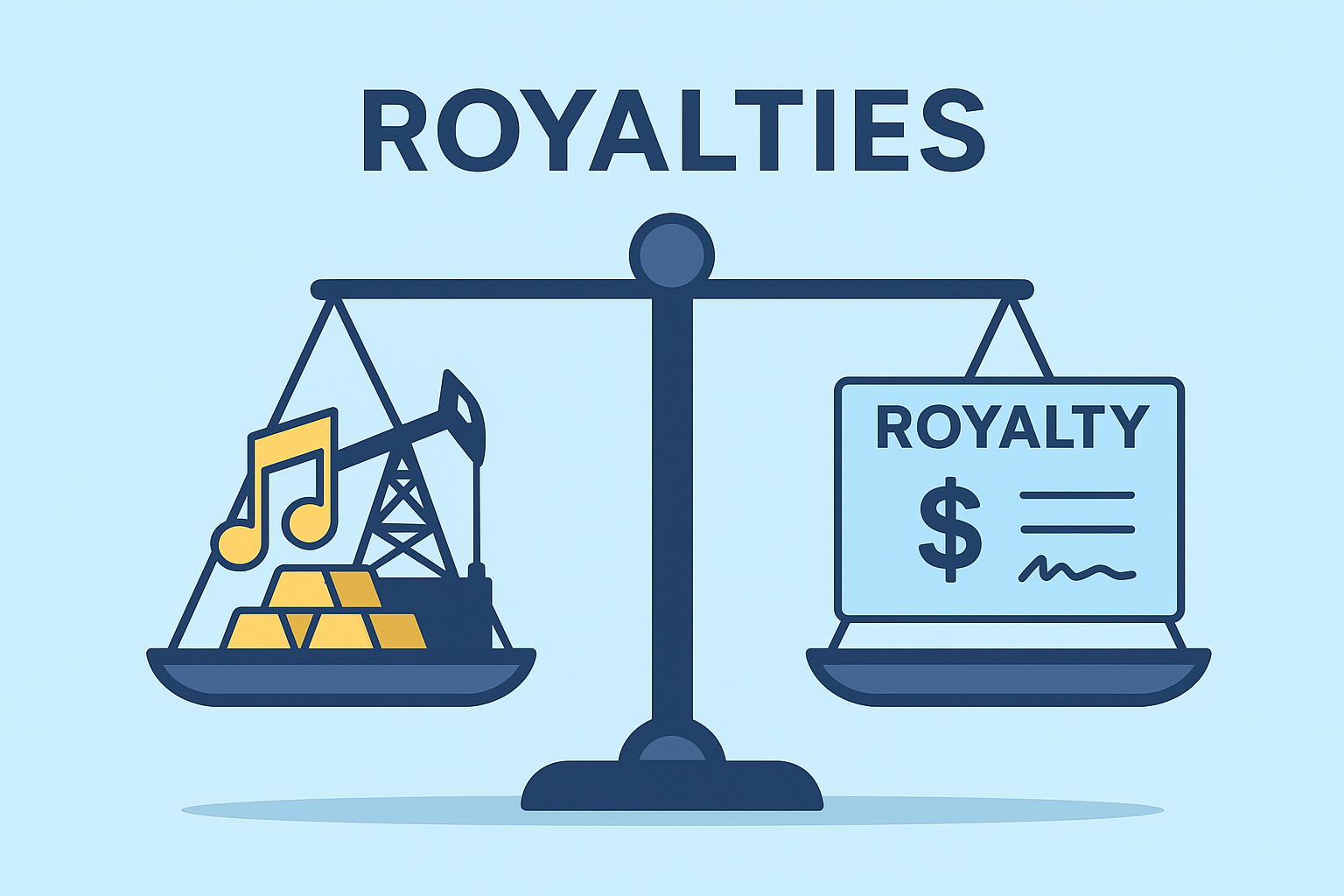Royalties are payments made to the owner of an asset, such as music, books, patents, or natural resources, when others use or sell that property, typically calculated as a percentage of sales, revenue, or production. Return on Equity
TL;DR
Royalties Explained in Plain English
- Royalties are payments to creators/owners when others use their assets.
- Common in music, books, oil & gas, patents, and franchises.
- Typical rates: 8–25% depending on industry.
- Investors can access royalties via trusts and funds.
- Future: blockchain, AI, and new royalty models.
What Are Royalties?
Royalties are compensation paid to creators, inventors, or resource owners when someone else uses their work or property. Common examples include:
- Authors earn a percentage of book sales.
- Musicians receive payments when their songs are streamed or performed.
- Inventors licensing patents to companies.
- Landowners collecting oil, gas, or mining royalties.
They serve as a bridge between intellectual property rights and income generation, rewarding creators for ongoing use of their assets. Investopedia
Why Royalties Matter in Finance
Royalties aren’t just a creative paycheck; they are:
- A steady stream of passive income for owners.
- A taxable income source, subject to IRS royalty income rules (IRS guidelines).
- A unique investment opportunity, especially in industries like energy, music, and pharmaceuticals. Morningstar
How Do Royalties Work?
Here’s a simplified royalty payment flow:

- Agreement signed: Terms define percentage, advance, or minimum payment.
- Use occurs: A book is sold, an oil well produces, a song streams.
- Payment made: Licensee sends royalty payments (monthly, quarterly, annually).
Royalty rates can be fixed, sliding scale, or performance-based. SEC
Types of Royalties
| Type of Royalty | Who Earns It | How It Works / Key Details | Typical Rate or Range |
|---|---|---|---|
| Music Royalties | Songwriters, composers, recording artists | – Mechanical royalties: earned from CDs, vinyl, and streaming downloads. – Performance royalties: from radio, live performances, and public plays. – Synchronization royalties: when songs are used in movies, TV, or ads. | Varies by platform and licensing deal |
| Book Publishing Royalties | Authors | Authors receive a percentage of book sales; any advance is deducted from future royalties. | 8–15% of book sales |
| Oil, Gas, and Mining Royalties | Landowners or mineral rights holders | Energy companies lease land/mineral rights and pay a share of production revenue. | 12.5–25% of production revenue |
| Patent Royalties | Inventors, scientists, engineers | Companies license patented technologies or drugs and pay royalties on product sales. | 2–10% of sales |
| Franchise Royalties | Franchisors (brand owners) | Franchisees pay ongoing fees based on gross revenue for use of brand and business model. | 4–8% of revenue |
Royalty Rates by Industry
| Industry | Typical Royalty % | Source |
|---|---|---|
| Books | 8–15% | Publishers Weekly |
| Music | 10–20% | RIAA |
| Pharma Patents | 2–10% | WIPO |
| Oil & Gas | 12.5–25% | U.S. Energy Info Admin |
| Franchises | 4–8% | Franchise.org |

Comparison: Royalties vs Dividends vs Bonds
| Feature | Royalties | Dividends | Bonds |
|---|---|---|---|
| Income Source | Asset use/licensing | Company profits | Loan interest |
| Predictability | Medium | Medium | High |
| Growth Upside | High (if asset popular) | Medium | Low |
| Tax Treatment | Ordinary income | Qualified dividends | High (if asset is popular) |
How Royalty Payments Are Calculated
- Gross revenue from sales: $100,000.
- Royalty contract rate: 10%.
- Payment to rights owner = $10,000.

Investing in Royalties
Royalties can be turned into investments:
- Royalty Trusts → Trade on stock exchanges (common in the energy sector).
- Music Royalty Funds → Investors buy shares backed by song catalogs.
- Franco-Nevada (FNV) → A gold-focused royalty & streaming company.
Performance Example: Franco-Nevada vs S&P 500
Franco-Nevada’s growth outpaced the S&P 500, showing how royalties can hedge against market cycles. IRS royalty tax page
Royalty Agreements & Tax Implications
Common Contract Structures
- Flat % of sales
- Tiered rates (e.g., 10% up to $1M, then 15%)
- Advance + ongoing (common in publishing/music)
Tax Treatment (U.S.)
- Most royalties = ordinary income, taxed at your marginal rate.
- Can qualify for capital gains if selling the underlying rights.
- IRS Guide on Royalties
Risks of Relying on Royalties
- Contract disputes (ownership rights).
- Market shifts (streaming upended CD royalties).
- Declining demand for certain resources.
- Taxation complexity under IRS royalty rules
Future of Royalties
- Blockchain/NFT royalties may automate payouts for creators.
- AI-generated content raises questions of who receives royalties.
- Globalization will expand royalty opportunities across borders.
Yes, but they are taxable and depend on contract terms.
Royalties are typically taxed as ordinary income by the IRS.
Yes, via royalty trusts, royalty ETFs, or direct catalog purchases.
Music, books, oil/gas, patents, and franchises.
Dividends come from company profits, while royalties come from the usage of an asset.
Final Thoughts
Royalties represent a fascinating blend of law, finance, and creativity. They reward asset owners for their ideas and resources while giving investors a unique source of cash flow.
Disclaimer
This article is for educational purposes only. It does not constitute financial, tax, or legal advice. Please consult with a licensed advisor.
Author Bio
Max Fonji is the founder of TheRichGuyMath.com, a finance and investing education platform focused on clear explanations, data-driven insights, and building financial literacy for beginners and pros alike. With 8+ years of combined expertise in markets, personal finance, and wealth building, our mission is to simplify complex financial concepts so you can make smarter money decisions.






